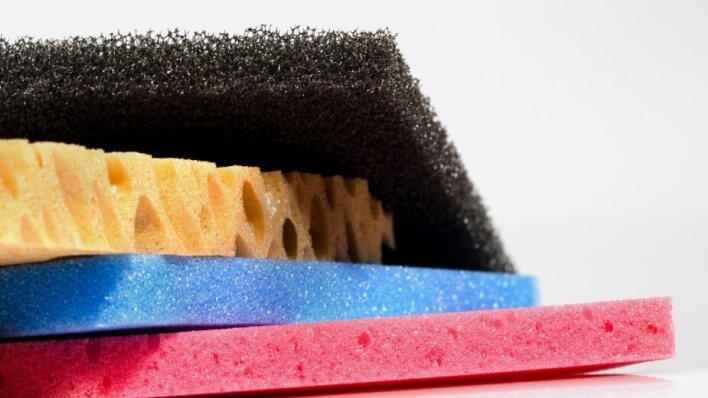
PUR flexible foam materials
PUR flexible foam materials are among the materials with the most versatile application and solution potential — and have been part of our core business for 60 years.
On account of their open cellular structure and elastic walls, PUR foam materials are very flexible and, depending on the type, recover well. The open cellular structure also ensures high permeability to air and absorption of liquids.
Because of these properties, flexible foam materials are used not only for mattresses, but also as cushioning materials in the furniture and automotive industries. As a result of their shock-absorbing properties and high flexibility, they play an important role in packaging. In industrial and technical applications, they are used as seals and for vibration and sound absorption. In the consumer sector, they are indispensable as materials for cleaning and care sponges.
Polyurethanes are reactive polymers. A PUR reaction system typically consists of two raw material components and additives such as colour pigments, fillers, and foaming agents in the case of foam materials. The raw material components are polyols and isocyanates. When mixed with the foaming agent, they react to form polyurethane (PUR). The foaming agent produces gas inclusions that make up the cells or pores in the foam material. PUR foam materials are available in various degrees of hardness, ranging from soft to semi-hard to hard, depending on the application.
PUR flexible foam materials have an open cellular structure. This means that in the last phase of the foaming process, the cell walls burst open. A fundamental distinction is made between polyester and polyether foam materials, based on the polyols used. They each have different technical properties. Furthermore, PUR flexible foam materials mainly differ in their density, compression hardness, and cellular structure.
Density refers to the weight per unit volume of a foam material and is generally specified in kilograms per cubic metre. The compression hardness indicates how “solid” a foam material is, i.e. how much force is needed to compress it, and is typically indicated in kilopascals. The cellular structure influences the mechanical properties of the foam material and is carefully controlled during the foaming process. For filter foam materials, a very uniform and open cellular structure is usually desired, while the cell size varies based on the application. Sponge foam materials, on the other hand, mimic the irregular cellular structure of a natural sponge to ensure maximum liquid absorption.
The macro images on this page are intended to provide an overview of the special features of different foam materials. For the sake of clarifying the differences in cell size and structure, the same image excerpt is used throughout. Of course, many other types are available than those highlighted.
Ester foam materials
Ether foam materials
Filter foam materials

Jana Bastian
Sales
+49 (0)2645 9523-18
Send email

Richard Maier
Sales
+49 (0) 2645 9523-37
Send email

Arne Peuling
Sales
+49 (0) 2645 9523-43
Send email

Natalja Weigel
Sales
+49 (0) 2645 9523-28
Send email





